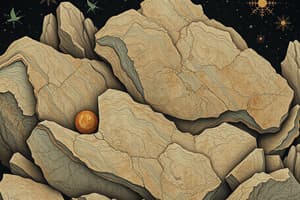Podcast
Questions and Answers
Which igneous texture is characterized by crystals too small to see?
Which igneous texture is characterized by crystals too small to see?
- Aphanitic (correct)
- Pegmatitic
- Glassy
- Phaneritic
Which texture would you associate with an igneous rock containing both large and small crystals?
Which texture would you associate with an igneous rock containing both large and small crystals?
- Porphyritic (correct)
- Pyroclastic
- Glassy
- Aphanitic
What type of igneous rock is primarily composed of lighter colored minerals?
What type of igneous rock is primarily composed of lighter colored minerals?
- Mafic
- Basaltic
- Felsic (correct)
- Granular
Bowen’s reaction series explains the formation of minerals based on what factor?
Bowen’s reaction series explains the formation of minerals based on what factor?
Which of the following textures indicates no crystal structure?
Which of the following textures indicates no crystal structure?
Mafic igneous rocks are primarily characterized by which components?
Mafic igneous rocks are primarily characterized by which components?
What is the result of progressive cooling of magma?
What is the result of progressive cooling of magma?
What process leads to the formation of igneous rocks from magma?
What process leads to the formation of igneous rocks from magma?
What does the composition of an igneous rock tell us?
What does the composition of an igneous rock tell us?
Which factor does NOT affect the texture of igneous rocks?
Which factor does NOT affect the texture of igneous rocks?
What type of igneous rock forms when magma solidifies below the surface?
What type of igneous rock forms when magma solidifies below the surface?
What happens to crystals when magma cools rapidly?
What happens to crystals when magma cools rapidly?
Which gas is NOT typically found dissolved in magma?
Which gas is NOT typically found dissolved in magma?
What describes the relationship between metamorphic and sedimentary rocks?
What describes the relationship between metamorphic and sedimentary rocks?
Which of the following describes the composition of magma?
Which of the following describes the composition of magma?
What is the primary reason for different compositions of igneous rocks formed from the same magma?
What is the primary reason for different compositions of igneous rocks formed from the same magma?
Flashcards are hidden until you start studying
Study Notes
Crystal Size in Igneous Rocks
- Extrusive igneous rocks have small crystals due to rapid cooling.
- Intrusive igneous rocks have larger crystals resulting from slow cooling.
- Unordered ions in rocks are referred to as glass.
Types of Igneous Textures
- Aphanitic texture: Fine-grained, crystals are too small to see.
- Phaneritic texture: Coarse-grained, crystals are large enough to be visible.
- Porphyritic texture: Mixed, contains both large and small crystals.
- Glassy texture: No crystal structure present.
- Pyroclastic texture: Composed of consolidated rock fragments.
- Pegmatitic texture: Features unusually large crystals due to high volatile content.
Igneous Rock Composition
- Primarily made of silicate minerals, includes Al, Ca, Na, K, Mg, Fe.
- Cooling magma leads to two major groups of silicates:
- Dark silicates: High in Mg and Fe, low in silica.
- Light silicates: High in silica, also contain Na, K, Ca.
Types of Igneous Rocks
- Mafic igneous rocks: Dark minerals, high in Mg and Fe, basaltic composition.
- Felsic igneous rocks: Light minerals, high in feldspar and silica, granitic composition.
Classification of Igneous Rocks
- Based on two main components:
- Composition: Relates to the parent magma.
- Texture: Reflects the cooling history.
Composition Determinants
- Magma cools over a range of temperatures, minerals form at varying times.
- Bowen’s reaction series illustrates the sequence of mineral formation during cooling.
Rock Cycle Overview
- Three rock types: igneous, metamorphic, and sedimentary are interrelated.
- Processes:
- Pressure and temperature lead to metamorphic rocks.
- Melting creates magma, which can solidify into igneous rocks.
- Crystallization of magma forms solids.
Magma: Parent Material
- Magma is molten rock from Earth’s interior; lava is magma at the surface.
- Extrusive/Volcanic igneous rocks: Form from solidified magma above ground.
- Intrusive/Plutonic igneous rocks: Form from solidified magma below ground.
Texture Formation Factors
- Texture is influenced by:
- Rate of cooling of magma.
- Amount of silica present.
- Quantity of dissolved gas.
- Rapid cooling leads to small crystals, while slow cooling allows for larger crystals to develop.
Studying That Suits You
Use AI to generate personalized quizzes and flashcards to suit your learning preferences.




